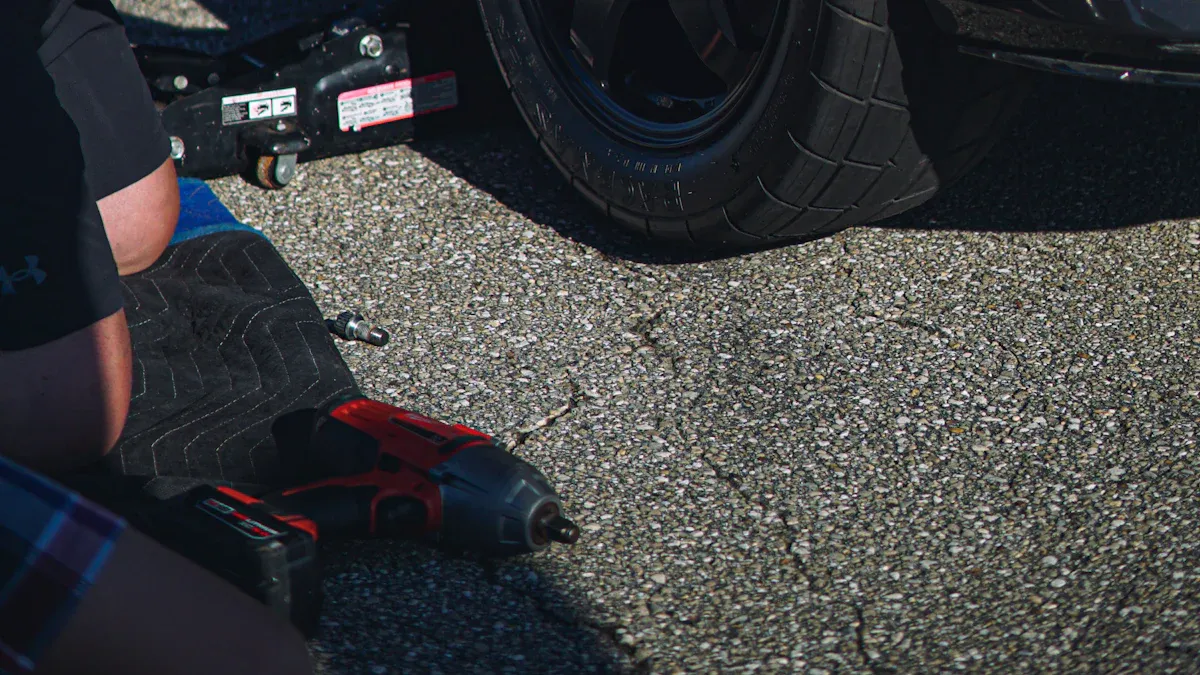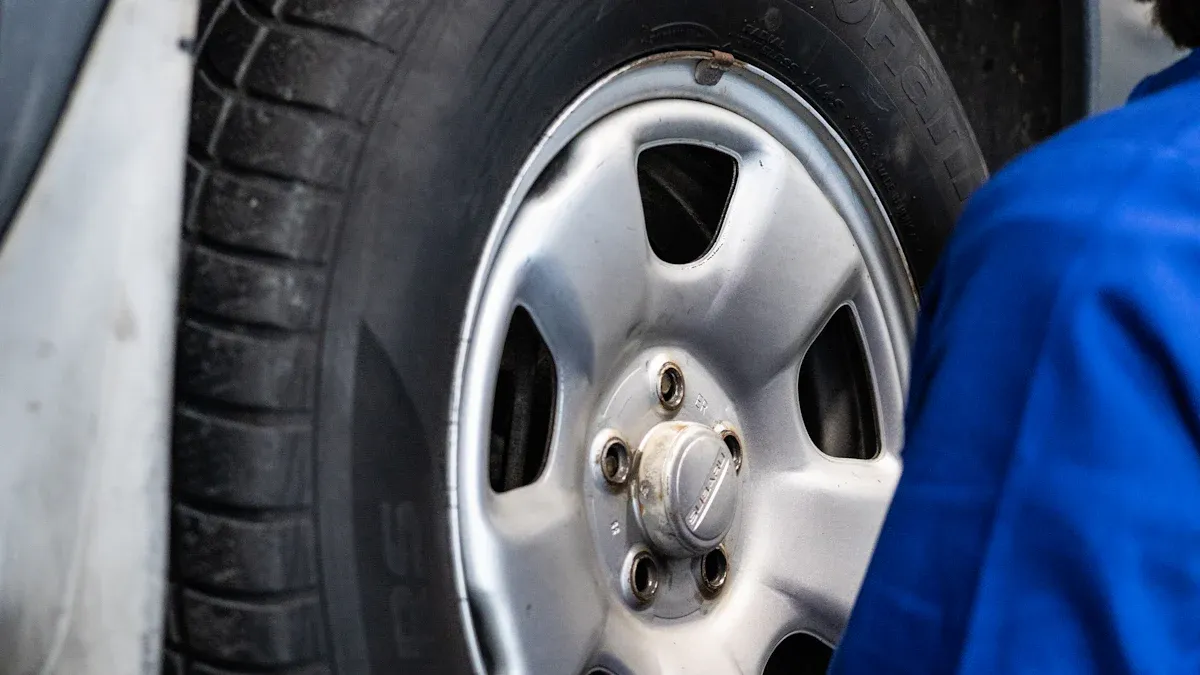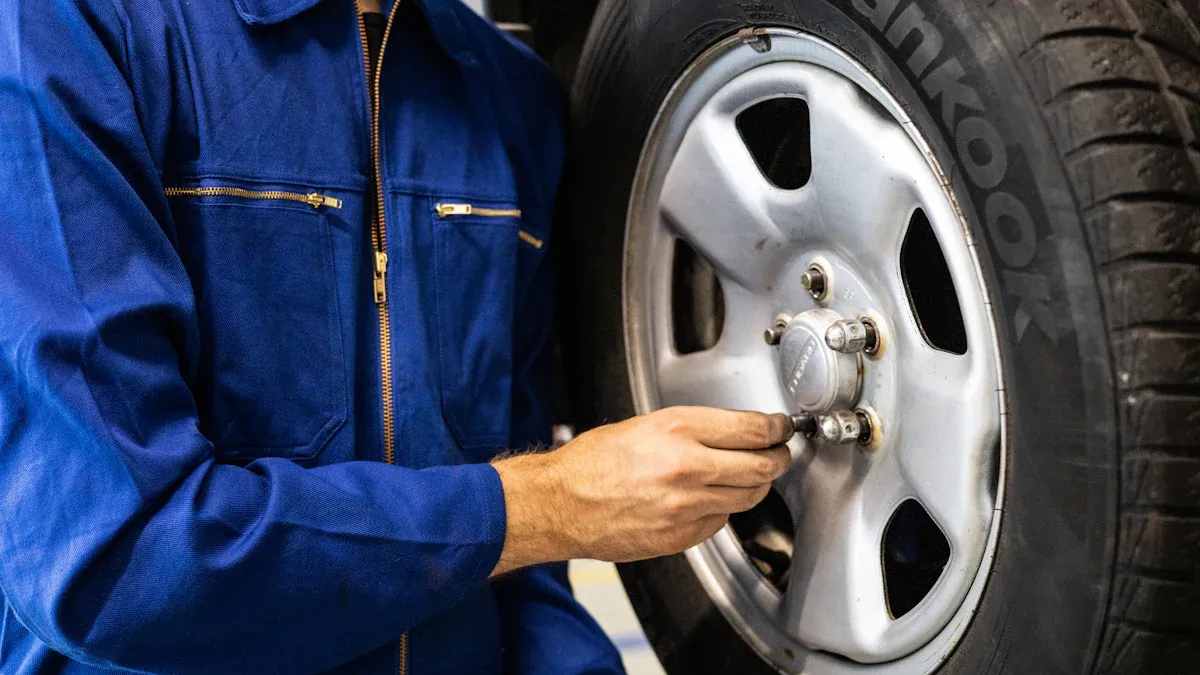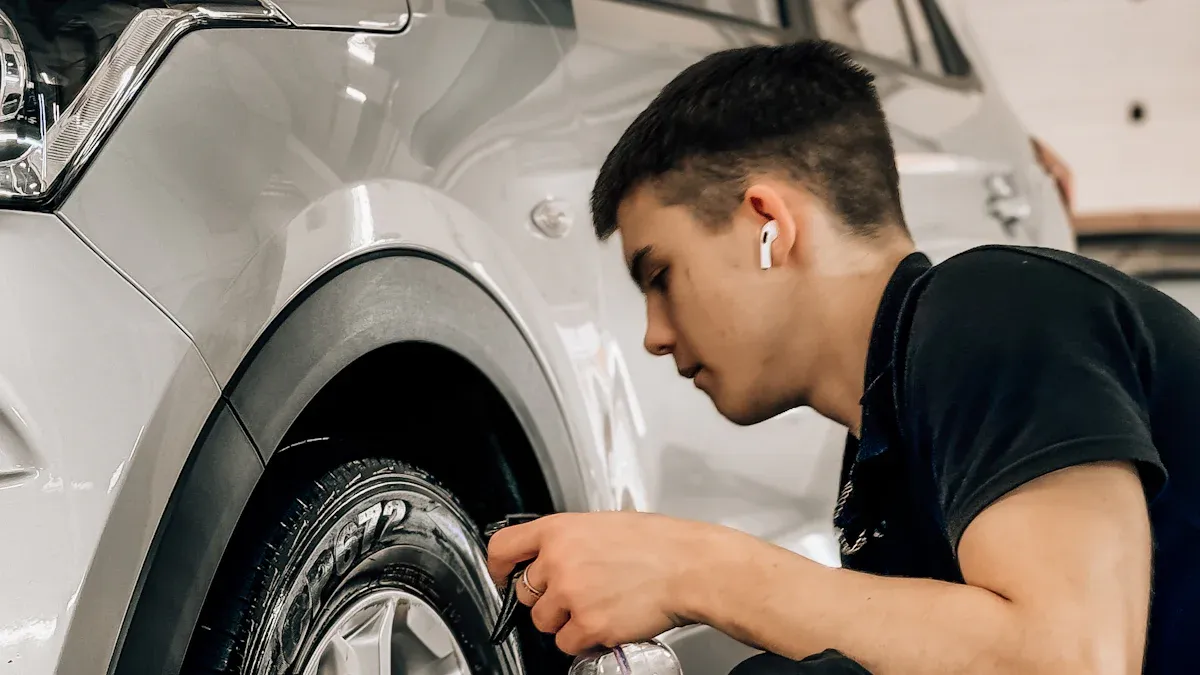
When you face a flat tire, you need a tire patch you can trust. Experts agree that a reliable solution seals the inside of the tire, fills the puncture, and uses strong materials that bond for lasting results. You want a tyre patch with tough adhesion, durability, and one that works for any tire type. SUNSOUL stands out because you get a patch that is easy to use and trusted worldwide for emergency repairs.
Key Qualities of a Reliable Tire Patch for Proper Tire Repair
Strong Adhesion and Leak-Proof Sealing
When you fix a tire, you want the vulcanizing tire patch to stick tight and stop air from leaking out. A good rubber tire patch uses strong adhesives and sealing materials. These create a bond that holds up even when your tire faces high pressure on the road. Here’s how a reliable patch keeps your tire sealed:
- You find the tire puncture by looking for bubbles with a soap-and-water mix.
- You pull out the object that caused the puncture.
- You clean and roughen the area with a rasp tool. This helps the patch grip the tire.
- You prepare the patch or plug, sometimes adding rubber cement for extra hold.
- You insert and set the patch or plug, making sure it fills the hole.
- You inflate the tire and check that the seal holds under normal pressure.
This process helps you drive safely after a flat tire, knowing the patch will not let air escape. You get peace of mind because the repair stands up to daily use.
Tip: Always check the seal after you finish the repair. A good seal means no more bubbles or hissing sounds.
Durability for Long-Lasting Tire Repairs
You want your tire repair to last, not just get you to the next stop. The best rubber patch for tires solutions use tough materials and smart technology. These patches can handle rough roads, heavy loads, and all kinds of weather. When you use a patch with vulcanizing gum or dual-cure technology, you get a bond that stays strong for years.
- High-quality tire patch kits create a permanent seal that keeps out water and dirt.
- Vulcanizing rubber seal technology makes the repair safe and long-lasting.
- Dual-cure patches use both heat and chemicals for the strongest bond.
- Strong construction materials help the patch handle stress from driving, even in tough jobs like farming or construction.
- Special adhesives and sealants keep the patch in place and stop leaks.
A proper tire repair with a patch can last seven to ten years if you follow the right steps. That’s much longer than a simple plug, which is only a quick fix. You get more value and safety from a patch that’s built to last.
Compatibility with Different Tire Types and Flat Tire Scenarios
You never know which tire will need a repair. That’s why you want a tire patch that works on many types of tires and in different situations. The best patches fit both radial and bias-ply tires. They work for cars, trucks, bikes, and even farm equipment. Some patches use dual-cure technology and special materials so you can use them on almost any tire.
| Tire Damage Scenario | Patch Solution Performance | Recommendation |
|---|---|---|
| Puncture within central repair area | Effective; patching can last 7-10 years if done properly | Patch recommended |
| Puncture less than 1/4 inch | Effective; suitable for patching | Patch recommended |
| Puncture on sidewall or shoulders | Not suitable for patching; outside safe repair zone | Replacement recommended |
| Puncture larger than 1/4 inch | Not suitable for patching | Replacement recommended |
| Repeated damage or thin tread depth | Patch not advisable | Replacement recommended |
| Sidewall cracks or excessive wear | Unsafe to patch | Replacement recommended |
You should use a patch for a tire puncture in the tread area, as long as the hole is not too big. If the damage is on the sidewall or the hole is larger than 1/4 inch, it’s safer to replace the tire. A versatile patch gives you more options and helps you handle most flat tire emergencies with confidence.
Ease of Use in Emergency Tire Situations
When you get a flat tire on the side of the road, you want a solution that works fast and does not make things harder. The best tire patch kits help you fix your tire quickly, even if you have never done a tire repair before. You do not want to fumble with tiny parts or read confusing instructions when you are in a hurry or it is raining outside.
Many drivers say that a good patch kit comes in a self-contained package. You open the case, and every tool you need is right there. You do not have to put anything together or search for missing pieces. Some kits even have a molded plastic case or a belt-strap pouch, so you can keep your tools off the ground and within reach. This makes tire patching much easier, especially at night or in bad weather.
Here are some features that make a tire patch kit easy to use during emergencies:
- All-in-one kits include everything you need for the repair, like patches, sealant, tools, and even a tire pressure gauge.
- Clear, simple instructions help you understand each step, so you do not waste time guessing what to do next.
- Large T-handles on tools give you better grip and leverage, making it easier to push the patch into the tire.
- Some kits have both fast CO2 cartridges and electric inflators, so you can pump your tire up quickly and get back on the road.
- You do not have to remove small parts like valve cores, which means you will not lose anything important during the repair.
- Carry cases keep your kit organized and easy to find in your trunk or glove box.
Tip: Always check that your tire patch kit is complete and ready to use before you need it. A missing tool or unclear instructions can slow you down when every minute counts.
A well-designed tire patch kit saves you time and stress. You can fix a flat tire in just a few minutes, even if you are not a tire repair expert. The right patch kit gives you confidence, knowing you can handle most roadside emergencies by yourself.
Essential Features to Look for in a Tire Patch Solution
High-Quality Materials and Construction
When you choose a tire patch, you want something built to last. The best patches use thick, flexible rubber and strong adhesives. These materials help the patch stick tightly and move with your tire as you drive. If you look at how different repair methods work, you’ll see why construction matters:
| Repair Method | Description | Reliability Impact in Emergencies |
|---|---|---|
| Plug-only | Inserted from outside without removing tire from rim; quick and inexpensive. | Unsafe: Does not allow internal inspection; air and moisture can seep in causing corrosion and weakening; increases failure risk. |
| Patch-only | Tire removed from rim; patch applied inside after inspection. | Considered improper by industry; may still allow air/moisture penetration; less reliable than combination repair. |
| Combination Repair | Tire removed; internal inspection; patch with plug applied together for a tight seal. | Industry recommended as the only proper and reliable method; ensures internal damage is addressed and sealed. |
You can see that a combination repair, which uses both a patch and a plug, gives you the most reliable fix. This method seals the hole and keeps out air and moisture, making it the top choice for proper tire repair.
Advanced Sealing Technology for Proper Tire Repair
Modern tire patches use advanced sealing technology to keep your tire safe and airtight. In the past, repairs didn’t last long and often leaked. Now, dual cure patches use both heat and chemicals to create a strong bond. This means your patch can handle heavy loads and high speeds without failing. Some patches even use self-healing materials that seal small punctures automatically, so you worry less about flats. New silicone-based sealants also help the environment by making recycling easier.
Lab tests for air retention use helium and nitrogen to check for leaks. These tests happen in special labs with strict standards, so you know the patch will hold air and keep you safe on the road.
Note: Advanced sealing technology means fewer repeat repairs and more time on the road.
Suitability for Emergency Flat Tire Repairs
When you get a flat tire on the highway, you need a quick fix. Emergency tire patch solutions are made for speed and ease. You can use them without special tools, and they work well for small punctures. Aerosol sealants and tire plugs let you seal the hole and inflate your tire enough to reach a safe place. These fixes are temporary, so you should visit a professional for a permanent repair soon after.
- Emergency patches and plugs are easy to use and fast.
- They work best for small holes in the tread, not the sidewall.
- You can apply them without removing the tire from the wheel.
- Always check your tire pressure after using an emergency fix.
If you want a permanent solution, a combination patch and plug repair is best, but you’ll need a shop for that. For emergencies, choose a patch kit that’s simple and quick to use.
SUNSOUL’s Standards for Reliable Tire Patch Products
When you pick a tire patch, you want to know it will work every time. SUNSOUL sets high standards so you can trust their patches, even in tough situations. With over 20 years of experience, SUNSOUL combines smart design, strong materials, and strict testing to make sure you get a patch that lasts.
SUNSOUL uses ISO-certified processes in their factories. This means every patch meets international safety and quality rules. You get patches made from high-temperature resistant and anti-aging synthetic rubber. These patches work in extreme heat or freezing cold, from -40°C to 120°C. You do not have to worry about your patch failing when the weather changes.
Here’s what makes SUNSOUL patches stand out:
- Vulcanized rubber with a strong adhesive layer bonds tightly to your tire, making a seal that lasts longer than regular glue.
- Some patches have reinforced cord layers. These help stop tears and prevent cracks, so your repair stays strong.
- The Pro Model patches beat industry adhesion standards by 30%. They stay put, even if you drive on rough roads or carry heavy loads.
- Made from natural rubber, SUNSOUL patches offer 20% more tear resistance than many other brands.
- Each patch can fix punctures up to 6mm wide, which covers most flat tire problems you might face.
- SUNSOUL patches hold DOT and ECE R109 certifications. These are the same safety standards car makers trust.
- You get a 1-year warranty. If your patch cracks or peels, SUNSOUL will replace it for free.
Tip: SUNSOUL uses eco-friendly, solvent-free adhesives. This keeps your tires safe and helps protect the environment.
SUNSOUL also cares about you after you buy. You get technical training, fast logistics, and 24/7 help in many languages. Their team makes sure you always have support, no matter where you are. When you choose SUNSOUL, you get more than a patch—you get peace of mind and a partner you can count on.
Tire Patch vs. Other Flat Tire Repair Methods
Tire Patch vs. Tire Plug: Which Is More Reliable?
You might wonder if you should use a tire patch or a tire plug when you get a flat. Both can help, but they work in different ways. A tire plug goes straight into the puncture from the outside. You can fix your tire fast, which is great for emergency roadside plug repairs. But plugs are usually just a quick fix. They might not last long, especially if you drive a lot or hit rough roads.
A tire patch, on the other hand, gets applied from inside the tire. You have to take the tire off the rim, but this method gives you a stronger, longer-lasting repair. Check out this table to see how they compare:
| Aspect | Tire Plug | Tire Patch |
|---|---|---|
| Application | Inserted from outside into puncture hole | Applied inside tire after removing from rim |
| Repair Time | Quick and easy | More time-consuming due to tire removal |
| Permanency | Generally temporary fix | Considered more permanent and reliable |
| Effectiveness | Best for small punctures | Can repair larger or irregular punctures |
| Risk of Failure | Possible plug falling out or air leaks | Strong seal, less likely to fail when properly applied |
Most experts say a patch is the better choice for proper tire repair. It seals the puncture from the inside and can last as long as the tire itself.
Tire Patch vs. Liquid Sealant for Emergency Repairs
Liquid sealants are another option when you need a fast fix. You spray the sealant into the tire, and it covers the hole so you can keep driving. This method is super convenient if you are in a hurry. However, sealants are usually temporary. They help you get to a shop, but they do not give you a solid, long-term repair.
Permanent sealants do exist, but they work best as a preventive measure. If you want a repair that lasts, a patch is the way to go. Patches create a strong seal and keep your tire safe for years. Sealants are great for emergencies, but you should always follow up with a proper tire repair.
Why Tire Patch Solutions Are Preferred for Proper Tire Repair
You want your tire to last and keep you safe. That is why professionals prefer tire patch solutions. Patches give you a strong, airtight seal from the inside. They work for many types of puncture, even larger ones. When a pro installs a patch, they check the tire for hidden damage. This step helps prevent future problems.
Here are some reasons patches are the top pick:
- Patches provide a more permanent fix than plugs or sealants.
- They help maintain the tire’s strength and safety.
- Professionals use special tools and high-quality patches for the best results.
- Many shops offer warranties on patch repairs, giving you peace of mind.
- Patches are a cost-effective solution because they help your tire last longer.
If you want a repair that keeps you rolling safely, choose a patch. It is the best way to handle most flat tire problems.
How to Identify a Reliable Tire Patch for Emergency Tire Repair
Checking Certifications and Customer Reviews
You want to make sure your tire patch will hold up when you need it most. Start by checking for certifications and reading what other drivers say. Look for patches that meet industry standards like ASTM F1971-19 for tubeless tire repair or DOT safety rules. Trusted brands often show off their ISO 9001 or TIA certifications right on the box. These marks mean the patch has passed tough tests for strength, air retention, and temperature resistance.
Customer reviews can tell you a lot, too. If you see a high re-order rate or lots of positive feedback, you know people trust that patch. Many drivers share stories about how a patch saved them on the road or lasted for years. When you see both strong certifications and happy customers, you can feel confident in your choice.
Recognizing Trusted Brands Like SUNSOUL
Not all tire patch brands are created equal. You want to pick a name that stands for quality and support. SUNSOUL is a great example of a trusted brand in the tire repair world. Here’s what sets top brands apart:
| Criteria Category | Specific Criteria / Metrics |
|---|---|
| Industry Standards | ASTM F1971-19, DOT standards |
| Certifications | ISO 9001, REACH/ROHS, TIA certification |
| Performance Benchmarks | Peel adhesion ≥40 N/cm, Temp. resistance -40°C to 120°C, Cure time ≤10 min, Air retention ≥95% after 72 hrs, Tensile strength ≥18 MPa, Aging resistance |
| Quality Assurance | Batch traceability, Third-party lab reports |
| Integration & Support | Compatibility with standard tools, Technical training, Adhesion failure warranties, 24-hour logistics support |
You also want a patch made from high-quality natural rubber and vulcanizing gum. SUNSOUL patches fit many tire types, from cars to trucks and even bikes. They come in different sizes, so you can fix almost any flat. With over 20 years of experience and a 99% re-order rate, SUNSOUL shows that drivers trust their products. Their patches meet USA safety standards and come with an 18-month warranty. If you ever need help, their team offers fast, friendly support.
Understanding Packaging and Usage Instructions
A good tire patch kit makes repairs easy and safe. Always check the packaging before you buy. The best kits include every tool you need, like patches, glue, and a tire stitcher. Clear instructions matter, too. If you follow each step, your repair will last longer and keep you safe.
- Remove the tire from the rim so you can check for hidden damage.
- Clean and buff the puncture area to help the patch stick.
- Pull the plug through the hole, add vulcanizing glue, and wait for it to cure.
- Press the patch onto the inner liner and use a stitcher to remove air bubbles.
- Put the tire back on, inflate it, and check for leaks. If you have any doubts, visit a reputable tire repair shop for a professional inspection.
When you use a kit with clear instructions and all the right tools, you get a repair that lasts. Experts say this is the only way to make sure your tire stays safe on the road.
Step-by-Step Guide to Using a Tire Patch for Flat Tire Emergencies

Preparing the Tire and Tire Patch
Getting ready is the most important part of the tire repair process. If you skip steps, your patch might not hold. Here’s how you can prepare your tire and patch for the best results:
- Take the tire off the rim so you can see the damage clearly.
- Look closely at the puncture. Make sure it is not too big or on the sidewall.
- Clean the area around the hole. Use a rubber cleaner to get rid of dirt and grease.
- Buff or roughen the surface with a special tool. This helps the patch stick better.
- Wipe away any dust from buffing.
- Apply a thin, even layer of vulcanizing fluid to the area. Let it dry until it feels tacky.
- Get your patch ready by peeling off the backing.
Tip: Always follow the instructions from your patch kit. This helps you avoid mistakes and keeps your repair safe.
Applying the Tire Patch Correctly
Now you are ready to fix the tire. Place the patch right over the puncture. Press it down firmly with your fingers. Use a tire roller or pressing tool to push out any air bubbles. Roll from the center out to the edges. This step makes sure the patch bonds tightly to the tire.
Let the patch cure for the time listed in the instructions. Most patches need about 10-15 minutes. Do not rush this step. If you move too fast, the patch might not seal well.
Common mistakes to avoid:
- Do not patch holes on the sidewall.
- Never skip cleaning or roughening the area.
- Do not use a patch that is too small for the hole.
Ensuring a Secure and Lasting Tire Repair
After you finish, check your work. Inflate the tire and listen for hissing sounds. You can also spray soapy water on the patch. If you see bubbles, air is leaking and you need to try again.
A good patch will last as long as the tire if you follow each step. If you feel unsure, ask a professional to check your repair. Sometimes, hidden damage can cause problems later.
Remember: A careful tire repair keeps you safe and helps your tire last longer. Always double-check your work before you drive away.
Safety Tips and Best Practices for Proper Tire Repair

When to Use a Tire Patch vs. Seek Professional Help
You might wonder if you should fix a flat yourself or call a pro. The answer depends on the damage. If you spot a small puncture right in the tread and it’s less than 1/4 inch, you can usually patch it yourself. But some situations call for expert help. Take a look at this table to help you decide:
| Situation | What You Should Do | Why It Matters |
|---|---|---|
| Puncture in tread, < 1/4 inch | Patch at home | Safe and quick for small holes |
| Puncture on sidewall or shoulder | Replace the tire | Sidewall repairs are unsafe |
| Multiple or overlapping repairs | Replace the tire | Too many repairs weaken the tire |
| Large or angled puncture | Seek professional help or replace | Big or odd holes need expert inspection |
| Old, worn, or damaged tire | Replace the tire | Old tires may hide damage you can’t see |
If you ever feel unsure, ask a tire shop to check your punctured tires. They can spot hidden problems and make sure your ride stays safe.
Inspecting the Tire Repair Before Driving
After you patch a tire, always check your work before hitting the road. Here’s a simple checklist to follow:
- Make sure you only repaired the tread area, not the sidewall.
- Double-check that the puncture was less than 1/4 inch.
- Remove the tire from the rim to look for hidden damage inside.
- Use a patch and plug combo for the strongest fix.
- Never patch over an old repair or fix the same spot twice.
- Smooth the area inside the tire before sticking on the patch.
- Inflate the tire and listen for leaks or look for bubbles with soapy water.
- If you see any problems, replace the tire instead of risking a blowout.
Tip: A good repair can last up to 7 years if you follow these steps. Always balance the tire after fixing it to keep your ride smooth.
Keeping a Reliable Tire Patch Kit in Your Vehicle
You never know when you’ll get a flat. Keeping a tire patch kit in your car means you can handle small emergencies without waiting for help. Here’s why it’s smart:
- You can fix minor issues on the spot and avoid towing.
- A kit with a gauge and patches lets you check and fix tires anytime.
- You save money by skipping expensive roadside repairs.
- You feel more confident knowing you can handle a flat by yourself.
- Being prepared keeps you calm and safe, even if you’re far from home.
Note: Choose a kit that matches your vehicle type. Make sure it has everything you need for a quick repair, so you’re ready for any puncture.
When you need a quick fix for a flat tire, you want a patch that sticks well, lasts long, and works on any tire you have. SUNSOUL gives you trusted solutions that help you handle emergencies with confidence. Keep a reliable tire patch kit in your car. You will save time, stay safe, and get back on the road fast.
- Look for strong adhesion
- Choose easy-to-use kits
- Trust brands with proven quality
Don’t wait for a flat. Prepare now and drive worry-free!
FAQ
How long does a tire patch repair last?
A quality tire patch can last as long as the tire itself—often 7 to 10 years. If you follow the right steps and use a trusted brand like SUNSOUL, you get a strong, permanent fix for most tread punctures.
Can I use a tire patch on any type of tire?
You can use most patches on cars, trucks, bikes, and even farm equipment. SUNSOUL patches work with radial and bias-ply tires. Always check your patch kit for compatibility before you start your repair.
Is it safe to drive right after patching a tire?
Yes, you can drive once the patch cures and you check for leaks. Inflate the tire, listen for hissing, and use soapy water to spot bubbles. If you see no leaks, you’re good to go!
What should I keep in my emergency tire repair kit?
You need patches, vulcanizing fluid, a rasp tool, a tire pressure gauge, and clear instructions. SUNSOUL kits include everything you need. Keep your kit in your trunk so you’re always ready.
How do I know if a tire patch is high quality?
Look for certifications like ISO 9001 or DOT approval. Read customer reviews and check for strong adhesion, thick rubber, and clear instructions. Trusted brands like SUNSOUL offer warranties and support, so you know you’re getting a reliable product.




